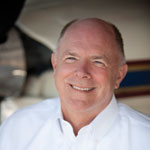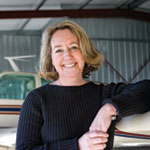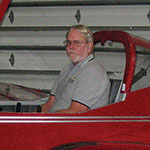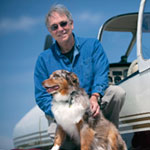 “It’s one of those happy/sad moments when you give away a sweepstakes airplane,” says Tom Horne, AOPA Pilot’s editor at large and project manager for the 2011 Crossover Classic restoration project (“ Crossover Classic Sweepstakes: The Ultimate Skylane ”). “I mean, you spend the better part of a year turning a frog into a prince—and then it’s time to let it go!” Yes, it’s true. Work on the Crossover Classic, a fully restored 1974 Cessna 182P, is complete save for a few minor items. Check out its path to like-new status on AOPA’s Sweepstakes Web page. But there’s at least one more flight for Horne to log—the one to the winner’s home airport. “It’ll be great to introduce the winner to this speedy super Skylane and its glass cockpit,” Horne adds. “And maybe he or she will let me visit it every once in a while!”
“It’s one of those happy/sad moments when you give away a sweepstakes airplane,” says Tom Horne, AOPA Pilot’s editor at large and project manager for the 2011 Crossover Classic restoration project (“ Crossover Classic Sweepstakes: The Ultimate Skylane ”). “I mean, you spend the better part of a year turning a frog into a prince—and then it’s time to let it go!” Yes, it’s true. Work on the Crossover Classic, a fully restored 1974 Cessna 182P, is complete save for a few minor items. Check out its path to like-new status on AOPA’s Sweepstakes Web page. But there’s at least one more flight for Horne to log—the one to the winner’s home airport. “It’ll be great to introduce the winner to this speedy super Skylane and its glass cockpit,” Horne adds. “And maybe he or she will let me visit it every once in a while!”
 “In the nearly 15 years I’ve been with AOPA Pilot, I had never been to Wichita,” says Managing Editor Julie Summers Walker. “At the Wichita Aero Club event, one gentleman wondered how I could possibly have gotten my job without having ever visited the Air Capital of the World! After several days in Wichita, I wondered, too” (“ There’s No Place Like Home ”). Walker was overwhelmed by the size and magnitude of the facilities that house the manufacturing of general aviation aircraft. Sprawling across the flat landscape, these massive buildings tell the story of how important aviation is to Wichita. “But the story is in the people of Wichita who face the uncertainty of an industry that mirrors the nation’s economic struggles,” she says. “I looked, but couldn’t find the sad faces. In Wichita, you might get down, but you don’t get out.”
“In the nearly 15 years I’ve been with AOPA Pilot, I had never been to Wichita,” says Managing Editor Julie Summers Walker. “At the Wichita Aero Club event, one gentleman wondered how I could possibly have gotten my job without having ever visited the Air Capital of the World! After several days in Wichita, I wondered, too” (“ There’s No Place Like Home ”). Walker was overwhelmed by the size and magnitude of the facilities that house the manufacturing of general aviation aircraft. Sprawling across the flat landscape, these massive buildings tell the story of how important aviation is to Wichita. “But the story is in the people of Wichita who face the uncertainty of an industry that mirrors the nation’s economic struggles,” she says. “I looked, but couldn’t find the sad faces. In Wichita, you might get down, but you don’t get out.”
 “I’ve been around a lot of homebuilt airplane projects,” says author Ken Scott. “Many of them never made it to the finish line, so when I heard a rumor about some guys scratch-building a replica of Howard Hughes’ H–1 Racer, I mentally consigned it to the ‘yeah, right’ file (“ Fleeting Beauty ”). “But I was so wrong. When the rumors refused to fade, I flew down to Cottage Grove, Oregon, and got my first look at Jim and Betty Wright’s Hughes Racer. It was one of the most beautiful manmade objects I had ever seen.” Later Scott returned to research the story and the entire crew spent an afternoon—on what should have been their day off—explaining the project and answering questions. “The Racer was an incredible airplane, but even more impressive was how it came to be: a group of exceptional craftsmen recreated something they felt deeply about, led by a man who radiated a real joy in simply living and doing good work. Every once in a while—if we’re lucky—we’re privileged to get a glimpse of something special. For me, that was the Racer.”
“I’ve been around a lot of homebuilt airplane projects,” says author Ken Scott. “Many of them never made it to the finish line, so when I heard a rumor about some guys scratch-building a replica of Howard Hughes’ H–1 Racer, I mentally consigned it to the ‘yeah, right’ file (“ Fleeting Beauty ”). “But I was so wrong. When the rumors refused to fade, I flew down to Cottage Grove, Oregon, and got my first look at Jim and Betty Wright’s Hughes Racer. It was one of the most beautiful manmade objects I had ever seen.” Later Scott returned to research the story and the entire crew spent an afternoon—on what should have been their day off—explaining the project and answering questions. “The Racer was an incredible airplane, but even more impressive was how it came to be: a group of exceptional craftsmen recreated something they felt deeply about, led by a man who radiated a real joy in simply living and doing good work. Every once in a while—if we’re lucky—we’re privileged to get a glimpse of something special. For me, that was the Racer.”
 “There are few things pilots fear more than losing their medical. Not only are you facing a major health issue, but you’re contemplating losing your freedom to fly as pilot in command,” says Charles Stites, executive director of Able Flight (“ Affair of the Heart ”). After a surprisingly short time from first symptoms to having a stent put in while traveling to EAA AirVenture in 2010, Stites confronted the issue head on by aggressively preparing for success on the first possible day he could get his medical back. “I began by researching the FAA’s recertification and documentation procedures the day after I got out of the hospital, and I followed them in every detail. And I’ve been just as aggressive in doing everything I can to protect my health and my medical certificate,” he says. His plan worked, and now once again he enjoys flying his 1949 Ryan Navion.
“There are few things pilots fear more than losing their medical. Not only are you facing a major health issue, but you’re contemplating losing your freedom to fly as pilot in command,” says Charles Stites, executive director of Able Flight (“ Affair of the Heart ”). After a surprisingly short time from first symptoms to having a stent put in while traveling to EAA AirVenture in 2010, Stites confronted the issue head on by aggressively preparing for success on the first possible day he could get his medical back. “I began by researching the FAA’s recertification and documentation procedures the day after I got out of the hospital, and I followed them in every detail. And I’ve been just as aggressive in doing everything I can to protect my health and my medical certificate,” he says. His plan worked, and now once again he enjoys flying his 1949 Ryan Navion.


